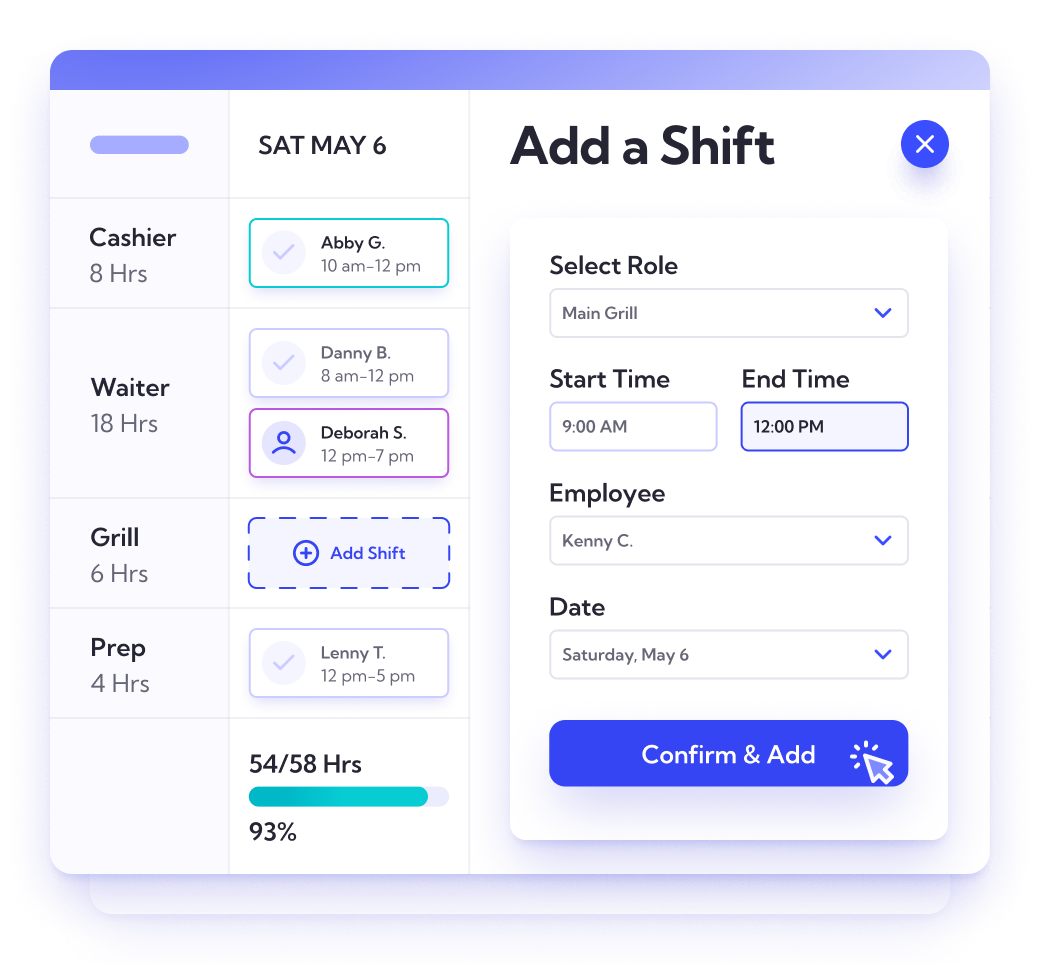According to a study, over 50% of workers in the hospitality industry prioritize the ability to work flexibly as much as they do pay and benefits when choosing a job.
With employees seeking more control over their work-life balance and employers aiming to optimize staff allocation, split shifts emerged as a practical solution.
The adoption of split shifts has proven instrumental in managing workforce fluctuations, reducing labor costs and ensuring exceptional service delivery during peak hours.
Understanding Split Shifts in the Restaurant Industry
Split shifts refer to a restaurant work schedule where an employee's work hours are divided into two or more segments within a single workday.
Unlike traditional shifts that consist of continuous work hours, split shifts involve a gap of time between the segments, allowing employees to have an extended break or period of time off before returning to complete their shift.
Typically, these shifts involve dividing the workday into two distinct parts, allowing employees to work a set of hours in the morning or afternoon and return for a dinner shift or a night shift later in the day.
By having the opportunity to work in two distinct shifts during a day, they can manage personal commitments alongside their professional responsibilities such as childcare, education, etc. By implementing split shifts, restaurants can meet their employees' needs while also ensuring adequate coverage during busy periods.
For example, a server who works during the lunch rush from 11 AM to 2 PM and returns for the dinner service from 5 PM to 9 PM can attend to personal matters during the break. it's important to note that the standard one-hour lunch break commonly associated with a traditional 9-to-5 schedule is distinct from a split shift.
Before implementing split shifts, it's essential to consider several factors. These include the size and type of your restaurant, staff availability and preferences, peak hours and customer demand patterns, and local labor laws and regulations. Assessing these factors ensures that split shifts will benefit both your restaurant and your employees.
For instance, a small, family-owned restaurant might not benefit from split shifts as much as a larger establishment with a higher customer volume during peak hours. It is also essential to understand your employees' availability and preferences to create schedules that accommodate their needs while maintaining efficient operations.
In the United States, the laws concerning split shifts vary depending on the state and local regulations. Typically, there are specific guidelines for minimum wage, maximum work hours, and mandatory break intervals that employers must adhere to when implementing split shifts.
Additionally, there are federal laws, such as those outlined by the Fair Labor Standards Act (FLSA), which establish minimum wage requirements and regulations concerning overtime pay for non-exempt employees. These laws are in place to protect the rights and interests of workers and ensure fair compensation for their work.
Employers should always stay informed about both federal and state regulations to ensure compliance and fair treatment of their employees.
Check out our free restaurant work schedule template.

Advantages of Implementing Split Shifts
Enhanced Flexibility for Employees and Employers
Split shifts offer a unique advantage by providing enhanced flexibility for both employees and employers. This flexibility allows employees to manage personal commitments and obligations effectively while fulfilling their work responsibilities. Employers, on the other hand, benefit from a workforce that can adapt to varying operational demands, thereby ensuring consistent and efficient service delivery during peak hours.
By leveraging the enhanced flexibility offered by split shifts, restaurants can foster a harmonious work environment that accommodates the diverse needs and preferences of their workforce, ultimately contributing to improved employee satisfaction and operational efficiency.
Optimal Utilization of Peak Hours for Improved Service
Optimizing resource utilization during peak hours is a key advantage of implementing split shifts in the restaurant industry.
By strategically scheduling staff members during high-traffic periods, restaurant owners and managers can ensure that customer demands are met promptly and efficiently. This optimized staffing approach not only enhances the overall customer experience but also contributes to increased operational productivity and revenue generation.
Leveraging split shifts to capitalize on peak hours can significantly bolster the reputation and profitability of the restaurant, positioning it as a preferred dining destination for patrons seeking exceptional service and culinary experiences.
Increased Productivity
According to a research, employees become less productive the longer they work. While employees may initially demonstrate high levels of productivity, this tends to decline as the work hours extend. Factors such as fatigue and decreased concentration can contribute to reduced efficiency and output. Moreover, prolonged work hours can lead to burnout, affecting employees' overall well-being and job satisfaction.
Enhanced productivity is a key benefit associated with the implementation of split shifts in the restaurant industry. By providing employees with a flexible type of schedule, restaurant owners and managers empower their workforce to manage work commitments more efficiently, leading to heightened productivity and job satisfaction.

Best Practices for Successful Integration of Split Shifts In Restaurants
1. Follow Local and Federal Laws
Adhering to local and federal laws pertaining to scheduling practices is paramount in ensuring the seamless integration of split shifts.
This includes a comprehensive understanding of regulations governing working hours, break intervals, and overtime compensation. By complying with these laws, restaurant owners and managers can foster a work environment that prioritizes employee rights, thereby avoiding potential legal repercussions and fostering a culture of transparency and compliance.
California
In California, state labor laws mandate that employers pay an extra hour at the higher of the local or state minimum wage rate as a split shift premium for each split shift worked. Employers must also clearly inform employees about the split shift schedule and compensation, ensuring transparency and adherence to regulations. Here are a couple of states and their laws regarding split shifts:
New York
In New York, split shifts are regulated under the spread of hours law, which mandates additional compensation for employees whose number of hours extends over ten in a single workday, excluding meal breaks. This law ensures that employees receive proper compensation for their work when their shifts are split into two or more segments within a day.
Employers are required to provide additional pay to employees to bridge the gap between the start and end times of their work shifts, guaranteeing that their total compensation aligns with minimum wage standards and fair labor practices.
2. Evaluate Your Current Scheduling System
Start by analyzing your current scheduling practices to identify areas for improvement. Determine if split shifts can resolve any existing issues or if other scheduling methods may be more appropriate.
For example, if your restaurant experiences a significant drop in business during the afternoon, it may be more cost-effective to have employees work split shifts, allowing them to focus on other tasks or take a break during slow periods.
3. Utilize Technology
Developing clear and concise work schedules in a restaurant is crucial in preventing miscommunication and scheduling conflicts within the workforce.
Leveraging advanced technological tools like Lineup.ai's automated scheduling software can further streamline this process.
This AI-powered tool not only reduces the time spent on manual scheduling by creating optimal shift plans based on various factors such as employee availability and business demand but also allows for real-time adjustments and easy shift swapping.
By integrating such technology into the scheduling framework, restaurant owners and managers ensure that all employees are well-informed about their designated shifts and any scheduling changes, fostering an environment of transparency and operational efficiency

4. Communicate Effectively
Effective internal communication lies at the core of successful split shift integration.
Fostering open lines of communication between management and employees can help build trust and foster a collaborative work environment. This includes regular restaurant team meetings, one-on-one sessions with employees, and the establishment of feedback mechanisms.
5. Provide Adequate Breaks
Prioritizing the well-being of employees by providing adequate break intervals and fostering a healthy work-life balance is essential in preventing burnout and promoting overall employee satisfaction.
6. Offer Flexibility
Flexibility is key to successful split shift integration, as it allows employees to balance work commitments with personal responsibilities effectively. Offering flexible scheduling options, such as the ability to swap shifts or modify schedules based on individual needs, empowers employees to manage their work-life demands more efficiently.
7. Consider Commute Time
Commute time is a crucial factor to account for when implementing split shifts. Acknowledging the time employees spend traveling between home and work ensures realistic scheduling and helps maintain a healthy work-life balance.
8. Meticulously Maintain Shift Records
Keeping accurate and detailed records of employees' shifts is one of the essential traits of an effective restaurant manager. Proper documentation aids in monitoring work hours, shift specifics, breaks, ensuring compliance with labor laws, and addressing any concerns related to scheduling or compensation.
Final Thoughts
In conclusion, the strategic integration of split shifts in the restaurant industry presents a multitude of benefits for both employees and managers. By embracing the advantages through meticulous planning and implementation of best practices, restaurateurs can foster a positive work environment and ensure the seamless provision of exceptional dining experiences. The effective utilization of split shifts stands as a testament to the continuous evolution and refinement of operational strategies within the vibrant culinary landscape.
Further read:
